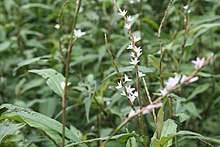Persicaria minor
Persicaria minor is a herb species of the family Polygonaceae, with synonym Polygonum minus, and is also known by the common names small water-pepper, small smartweed, pygmy smartweed, spotted lady's thumb and kesum (Malay). This herb is native to Asia, but distributed widely in Europe and Australia.[2] It is used in South East Asian cooking.
| Persicaria minor | |
|---|---|
 | |
| Scientific classification | |
| Kingdom: | Plantae |
| Clade: | Tracheophytes |
| Clade: | Angiosperms |
| Clade: | Eudicots |
| Order: | Caryophyllales |
| Family: | Polygonaceae |
| Genus: | Persicaria |
| Species: | P. minor |
| Binomial name | |
| Persicaria minor (Huds.) Opiz | |
| Synonyms[1] | |
|
Polygonum minus Huds. | |
Description
Persicaria minor is native to South East Asia, including Malaysia, Thailand, Vietnam and Indonesia.[3] It grows wild in cooler highlands, but is also found in wet lowland areas near rivers, ditches, and canals. It is a creeping plant with slender stems, and grows upright to a height of 1 to 1.5 meters. The creeping stem is green with reddish tinge, is cylindrical in shape, and has short nodes about 9 mm apart. Its leaves are long and narrowly-tapering, alternately arranged, and green with short, reddish petioles. Its flowers are minute, pale violet, and are 12 to 15 cm long.[4]
Uses
Persicaria minor is an edible herb. In Malaysia and Singapore, the shoots and young leaves are eaten raw as part of salad (ulam); used as an aroma spice additive in peppery dishes such as laksa, nasi kerabu, asam pedas and tom yam; used as tea leaves; and used for topical applications.[5] Its oil has been used for aromatherapy and in treatments for dandruff.
In Malaysian traditional medicine, P. minor has been used in post-natal tonics and for treatment of digestion.[4]
Pharmacological studies on P. minor have indicated anti-oxidant, LDL oxidation, anti-inflammatory and anti-microbial activities,[6] digestive enhancing and anti-ulcer activities,[7] as well as cognitive enhancing activities.[8] Comparative studies have been carried out to analyse the metabolites not only in the plant's leaves, but also in its stem and roots.[9]
References
- Tropicos, Persicaria minor (Huds.) Opix
- "Persicaria minor (Huds.) Opiz". New England Wild Flower Society. Retrieved 2017-03-28.
- Wan Hassan, W.E (2010). Ulam: Salad Herbs of Malaysia. Masbe. pp. 190–191. ISBN 9789834466404.
- Samy, Joseph; Sugumaran, M.; Lee, Kate (2005). Herbs of Malaysia. Times Editions - Marshall Cavendish. pp. 198–199. ISBN 9833001793.
- Kilham, Chris (2017-02-26). "South Asian herb dubbed 'smart weed'". FoxNews.com. Retrieved 2017-08-11.
- Christapher, Parayil; Parasuraman, Subramani (2015). "Review on Polygonum minus. Huds, a commonly used food additive in Southeast Asia". Pharmacognosy Research. 7 (1): 1–6. doi:10.4103/0974-8490.147125. PMC 4285636. PMID 25598627.
- Qader, SW; Abdulla, MA (2012). "Pharmacological mechanisms underlying gastroprotective activities of the fractions obtained from Polygonum minus in Sprague Dawley rats". International Journal of Molecular Sciences. 13 (2): 1481–1496. doi:10.3390/ijms13021481. PMC 3291972. PMID 22408403.
- George, A; Ng, CP (2014). "In vitro and ex-vivo cellular antioxidant protection and cognitive enhancing effects of an extract of Polygonum minus Huds (Lineminus™) demonstrated in a Barnes Maze animal model for memory and learning". BMC Complementary and Alternative Medicine. 14: 161. doi:10.1186/1472-6882-14-161. PMC 4036647. PMID 24886679.
- Ahmad, R; Baharum, SN (2014). "Volatile profiling of aromatic traditional medicinal plant, Polygonum minus in different tissues and its biological activities". Molecules. 19 (11): 19220–42. doi:10.3390/molecules191119220. PMC 6271663. PMID 25420073.
External links
| Wikimedia Commons has media related to Persicaria minor. |